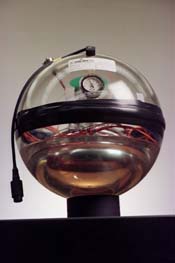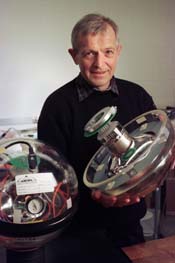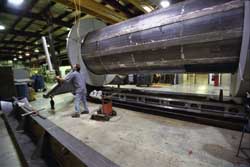
Caption:
The first map of the high-energy neutrino sky, produced with data from the
AMANDA II Telescope at the South Pole provides a tantalizing glimpse of
many potential point sources of the ghostlike cosmic neutrino. The preliminary
map, unveiled July 15, 2003 at a meeting of the International Astronomical
Union in Sydney, Australia, represents an analysis of one year of data from
the telescope and may encompass the first evidence of a cosmic accelerator
— bizarre, highly energetic phenomena such as crashing black holes
— but proof will require analysis of at least two more years of data.
Photo by: courtesy AMANDA Project
Date: July 2003
High Resolution JPEG 300
DPI

Source:
University of Wisconsin-Madison
Illustration by: Dan Brennan.
Larger low-resolution JPEG
EPS outline version of this image (2.5Mb
EPS)
For further assistance regarding the content of this illustration, contact
Terry Devitt, 608-262-8282, trdevitt@facstaff.wisc.edu.

Caption: Scientists with the National Science Foundation-funded AMANDA
Telescope project work at this South Pole research station. Their
neutrino detectors are sunk more than one-and-a-half kilometers
beneath the ice.
Photo by: Robert Morse
High Resolution JPEG 300 DPI

Caption: Scientists with the National Science Foundation-funded AMANDA
Telescope project drill deep holes such as this one in the South Pole
ice, where they have deployed an array of neutrino detectors. Sunk
more than one-and-a-half kilometers beneath the ice, the AMANDA
Telescope array is designed to look down through the Earth to the sky
in the Northern Hemisphere.
Photo by: Robert Morse
High Resolution JPEG 300 DPI

Caption: One of the crew at the South Pole station prepares to deploy an
optical module used to detect neutrinos. The AMANDA telescope array
consists of 677 optical modules, each the size of a basketball,
arrayed on electrical cables set deep in the ice beneath the South
Pole. The glass
modules at the heart of AMANDA work like light bulbs in reverse,
capturing the faint and fleeting streaks of light created when the
occasional neutrino crashes head on into another particle such as a
proton.
Photo by: Robert Morse
High Resolution JPEG 300 DPI

Caption: The photomultiplier tubes within these basketball-sized glass orbs are at the heart of the AMANDA neutrino telescope, a novel telescope being built at the South Pole to detect cosmic neutrinos.
Photo by: Jeff Miller
Date: March 1999
High Resolution JPEG 300 DPI

Caption: Physicist Francis Halzen holding the business end of a photomultiplier tube similar to the ones being used in the AMANDA neutrino telescope.
Photo by: Jeff Miller
Date: March 1999
High Resolution JPEG 300 DPI

Caption:
Bob Morse, physics.
Photo by: Jeff Miller
Date: March 2001
High Resolution JPEG 300 DPI

Caption:
Construction of a 33-foot long hose reel and sledge continues in the UW-Madison
Physical Sciences Laboratory in Stoughton, WI, as instrument maker Bart
Dana removes a level winder arm which will help coil 1.8 miles of hot water
hose evenly around the spindle. The reel, part of a drilling rig for the
IceCube neutrino telescope project, will be deployed to Antarctica in the
summer of 2003, where hot water will be used to drill through ice. A giant
sledge runner sits in the foreground at left.
Photo by: Michael Forster Rothbart
Date: December 2002
High-resolution 300 DPI JPEG








